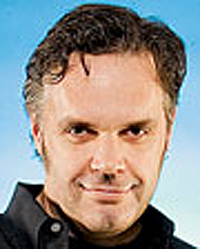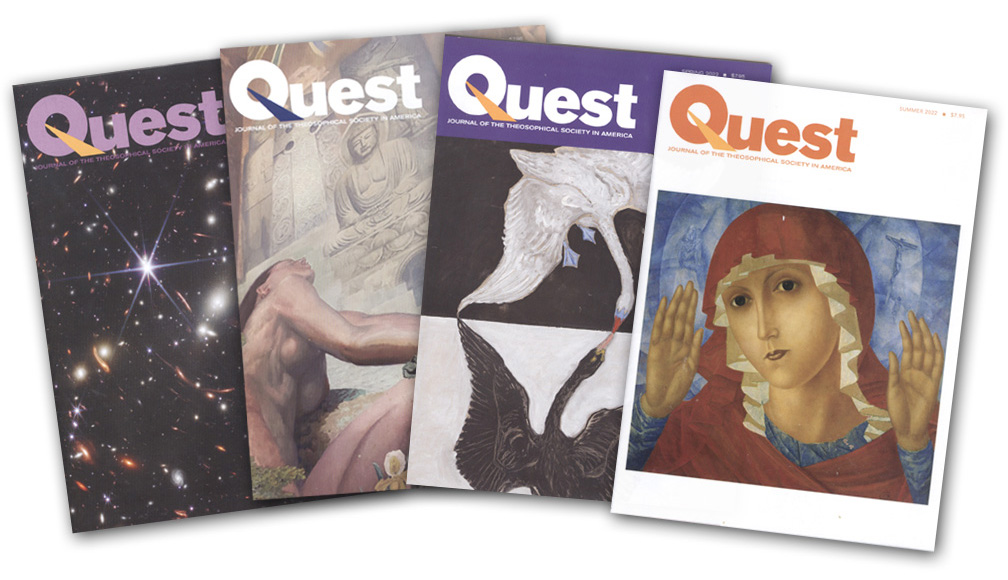Devic Consciousness
By Dora Kunz
Originally printed in the Fall 2009 issue of Quest magazine.
Citation: Kunz, Dora. "Devic Consciousness." Quest 97. 4 (Fall 2009): 152-153.
 When teaching meditation, I always suggest that we should try to listen to the sounds of the brook, birdsong, or the wind in the trees, for by so doing we open ourselves to the inner harmony of nature. It is the realization of this harmony that brings us in touch with the consciousness of the devas.
When teaching meditation, I always suggest that we should try to listen to the sounds of the brook, birdsong, or the wind in the trees, for by so doing we open ourselves to the inner harmony of nature. It is the realization of this harmony that brings us in touch with the consciousness of the devas.
Devas should not be thought of merely as spirits which animate nature. They are much more than that, for their consciousness reaches to the heights of buddhi, or direct insight into the archetypal ideas upon which the patterning of physical forms is based. They have a unitary concept of vital energies. Nature spirits, on the other hand, work directly with growing plants, interacting with these and with each other through the devic consciousness.
At Pumpkin Hollow, for instance, working in the garden sensitizes us to the different rhythms of the growing plants, and thereby we gain a sense of relationship not only with the devic consciousness which presides over the land, but also with the archetypal pattern they embody. If you are in harmony with that pattern it permeates you right to your fingertips, and then you can do with your hands what is right and good for the plants. When they are sick or ailing you get a sense of imbalance in their vital energies, and then you instinctively know what to do to correct it.
If you want to become sensitive to plants or trees you have to lose your sense of separateness. Setting aside your ego, you become aware of the vital energies you share with the rest of nature, and feel their rhythm. For example, when listening to the brook you must really listen, without letting ideas or mental images interfere and occupy your mind. It is through the rhythm of pure sound—which is eternal—that you can be genuinely influenced. This is the reason why Buddhists chant the mantra Aum. Through listening, we feel ourselves part of the eternal rhythm, one with the flow of the river. It is like being washed clean of our distractions.
The ways we look at life give us what is called "eye knowledge," seeing things out there, separate from ourselves. This leads us to make judgments based on our reaction to the external aspects of things. We see nothing but the form, which at once either attracts or repels us. Devas, in contrast, perceive life in terms of energies; to them the harmonics and rhythms of nature are most important.
In my own work, I have learned to think of life in the same way, because I perceive disease not as a malfunction of a particular organ, such as the liver, but rather as a loss of synchronicity in the body's vital rhythms.
The development of sensitivity, whereby you can begin to feel at one with the devic consciousness, can start with a personal experiment. Pick out a tree, and acquire a personal relationship with it: go out to the tree and have a really friendly feeling towards it. Learning to be still is a key element in this practice, for without stillness within one cannot listen. Therefore, sit quietly and look around you at the grass, the trees, the bushes. Be still, let go, and feel this sense of harmony.
The experiment will not work unless you can experience the harmony for yourself. Therefore, choose a part of nature that appeals to you, whether it be wind or water, rocks or trees. But it is important that you really listen to the stream—well enough so that you can remember the sound when you are away from it. This focused listening can produce changes in your consciousness.
Such attunement to the rhythms of life is important if you would draw closer to devic consciousness. As we travel about, we see that every landscape has different trees, a different shape, a different rhythm. Try to become sensitive to these, to attune yourself to the rhythm of the consciousness of that particular place. You will find this very interesting, because there is an infinite variety of vital energies at play in nature. They are never static, and they give each place its special character.
The earth is full of vitality, and therefore it is very healing to be in contact with it through one's hands and feet. Long ago in Australia, C. W. Leadbeater used to insist that we children go barefooted. His theory was that there is an exchange of the Earth's magnetism with the chakras, or energy centers, in the feet. At Pumpkin Hollow you can test this for yourself, engaging in a healing exchange with these abundant energies.
Since we do have these centers in the hands, as well as in the feet, we can also be energized by touching a tree, which has a large amount of energy and its own stable pattern. If you are practicing healing, it is a good thing to recommend to patients. Sickness always results in a lack of energy; therefore have the patient touch or lean against a tree. By doing so he will be renewed in energy and calmed by the tree's stabilizing rhythm.
The most basic characteristic in nature is relatedness. Communication between one individual and another takes place wordlessly, through experience. Such practice is a useful training in sensitivity which, rightly used, can be energizing and extremely helpful in many ways.
Letting go of our preconceptions and learning to be still and listen can make a link with the devic consciousness. Because of the nature of that consciousness, this link is at the archetypal level, at the level of unitary concepts. But meditating in a place like Pumpkin Hollow also puts us into contact with the earth and its magnetism on the lowest physical level. Thus there is an energy exchange on several levels at once, and this can create remarkable changes in our own rhythms.
Some of those who come to Pumpkin Hollow are in the midst of emotional conflicts or preoccupied by personal problems, and because they do not let these go, they sometimes are not open to all the benefits Pumpkin Hollow has to offer. But if we can put such things aside for the moment, we will find that there is an enduring state of consciousness beyond any human conflict, and that this permeates the very atmosphere of the place. Pumpkin Hollow offers us an opportunity to contact the wider consciousness in nature, by letting go.
Pain and anger and anxiety are transitory, whereas within the cycling energies in nature there is a pattern of order that is eternal. Therefore, if we can recognize that in spite of our failures we always have access to the order and harmony which lies within, we gain certainty that there is something, some power, which lets us feel whole again.
Frailty and failure are part of the human pattern, but that is the challenge of life. Participation in the experiment in consciousness which I have described lets us experience the inner order within nature and within ourselves. This experience is both healing and holistic, for it puts us in touch with the background of our lives which is beyond frailty and failure—the reality which is eternal.


 The things of the world, according to reliable sources, are not as they appear. Nor are they otherwise. Little wonder then that so many spiritual traditions warn against the power of "false images." Consider certain venerable photographs in this regard, such as those in the family album or the old yearbook—how they attract and return the interested gaze until the image opens up like a tomb unsealed and the dead come back to life. This is the imagination let loose. The ordinary snapshot becomes a frolicsome illusion, which, if we are not careful, will lead us into delusion.
The things of the world, according to reliable sources, are not as they appear. Nor are they otherwise. Little wonder then that so many spiritual traditions warn against the power of "false images." Consider certain venerable photographs in this regard, such as those in the family album or the old yearbook—how they attract and return the interested gaze until the image opens up like a tomb unsealed and the dead come back to life. This is the imagination let loose. The ordinary snapshot becomes a frolicsome illusion, which, if we are not careful, will lead us into delusion. These days many are calling for a rejuvenation and revitalization of the Theosophical Society. At the risk of adding to the din, I thought I would throw out a few thoughts of my own.
These days many are calling for a rejuvenation and revitalization of the Theosophical Society. At the risk of adding to the din, I thought I would throw out a few thoughts of my own.
